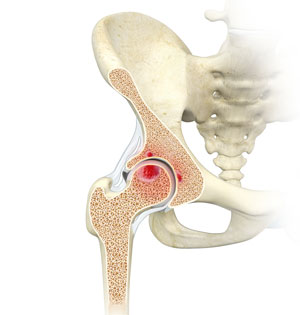
What are Hip Bone Cysts?
Hip bone cysts, also referred to as subchondral bone cysts, are fluid-filled sacs or spaces that form in one or both of the bones that make up a hip joint. The cysts develop just below the cartilage (tough spongy tissue) that covers the bone near the joint. The sacs typically consist of hyaluronic acid, a constituent found in synovial fluid, which is a thick substance that lubricates joints, enabling the bones to slide past one another without friction. Hip bone cysts are common in people with osteoarthritis.
Causes of Hip Bone Cysts
Hip bone cysts are commonly caused by osteoarthritis (OA), a degenerative joint condition and the most common form of arthritis, in which the cartilage between the joint wears away due to wear and tear over time or because of an injury to the joint. This affects the normal, smooth, sliding of one bone against another in your joints, causing more friction.
In some instances, a joint injury might also result in a cyst without OA.
Hip bone cysts can also form in cases of rheumatoid arthritis, another common form of arthritis, in which your immune system attacks and inflames your joints.
Risk Factors for Hip Bone Cysts
Some of the common risk factors for hip bone cysts include:
- Obesity
- Hereditary/family history
- Prior joint injury
- Abnormal joint shape and alignment
- Smoking
- Female gender
Signs and Symptoms of Hip Bone Cysts
The cysts by themselves do not seem to cause any major symptoms. However, symptoms may occur as a result of the underlying disease conditions such as osteoarthritis and rheumatoid arthritis. Some of the signs and symptoms of hip bone cysts include:
- Pain
- Swelling
- Stiffness
- Inflammation
- Reduced range of motion
- A protruding sac from the joint
Diagnosis of Hip Bone Cysts
In order to diagnose hip bone cysts, your physician will review your symptoms and conduct a thorough physical examination. During the physical examination, your physician will ask you to move your hip in different directions to determine which motions are restricted or painful. During the examination, if pain, swelling, or stiffness is noted and your physician presumes it to be a sign of osteoarthritis, rheumatoid arthritis, or joint injury, your physician may order tests such as X-rays, MRIs, and CT scans for a detailed evaluation of hip joint structures and to confirm the presence of hip bone cysts.
Treatment for Hip Bone Cysts
Hip bone cysts may not cause any symptoms. However, in some cases, the cysts may continue to grow and affect the way your joint functions. If this occurs, your physician may recommend a procedure called a fine needle aspiration in which a thin needle is inserted into the cyst under ultrasound or fluoroscopic guidance to drain the cyst.
Other than that, your physician may try to treat the underlying cause of the cyst such as osteoarthritis or a joint injury through conservative treatments such as nonsteroidal anti-inflammatory drugs (NSAIDs) to alleviate pain, weight loss to reduce pressure on the joints, low-impact exercises to improve or retain joint flexibility, ultrasound therapy, and physical therapy.
If none of these treatment measures help in relieving symptoms or provide the desired results, your physician may recommend hip joint replacement surgery as a final solution.




